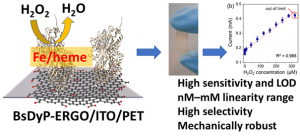
September 2022: The first paper in the field of enzyme-based biosensors for our group
A bacterial peroxidase (BsDyP) from the “dye-decolorizing” family was immobilized on electrochemically reduced graphene oxide (ERGO) deposited on indium tin oxide (ITO) and polyethylene terephthalate (PET) layers to create a mechanically robust biosensor with a shelf-life of eight weeks. This biosensor was characterized for the highly selective and sensitive detection of hydrogen peroxide (linearity 0.05–280 μM, LOD 32 nM).
Abstract
Enzyme-based electrochemical sensors have the advantage of possessing high selectivity for detection in a complex environment and therefore find applications in many areas, including non-invasive disease diagnosis, drug screening, food quality control and environmental monitoring. In this context, the accurate, rapid and online monitoring of H2O2 concentrations is of particular interest because it is a cellular metabolite whose production is connected to diseases such as cancer, diabetes, and cardiovascular and neurodegenerative disorders. Furthermore, H2O2 is a (by)product of multiple reactions that are relevant for biosensing in the food, medical, chemical and environmental sectors. Available methodologies to detect H2O2 include the use of spectrometry, photometry, fluorimetry, titrimetry and chemiluminescence. Although these techniques offer high accuracy, they are often time-consuming and cost-ineffective, thereby undermining their suitability for high throughput analysis. Enzyme-based electrochemical sensors can overcome these limitations by enabling simple, economically viable, high-sensitive and real-time monitoring of H2O2. However, the construction of a high-performance sensing device requires a combination of enzymes and electrode material with the optimal physicochemical properties and compatible methods to achieve stable enzyme immobilization.
In the article, our group has described the immobilization of a peroxidase from Bacillus s. (BsDyP) on electrochemically reduced graphene oxide (ERGO) deposited on indium tin oxide (ITO) and polyethylene terephthalate (PET) layers. XRD, SEM, AFM, FT-IR and Raman characterization of the sensor confirmed its structural integrity and a higher enzyme surface occupancy. The BsDyP-ERGO/ITO/PET electrode performed better than other horseradish peroxidase-based electrodes, as evinced by an improved electrochemical response in the nanomolar range (linearity 0.05–280 μM of H2O2, LOD 32 nM). The bioelectrode was mechanically robust, active in the 3.5–6 pH range and exhibited no loss of activity upon storage for 8 weeks at 4 °C.
Publication details
Sheetal K. Bhardwaj, Tanja Knaus, Amanda Garcia, Ning Yan, Francesco G. Mutti: Bacterial Peroxidase on Electrochemically Reduced Graphene Oxide for Highly Sensitive H2O2 Detection. ChemBioChem, 2022, 23, e20220034 (8 pages). DOI: 10.1002/cbic.202200346



